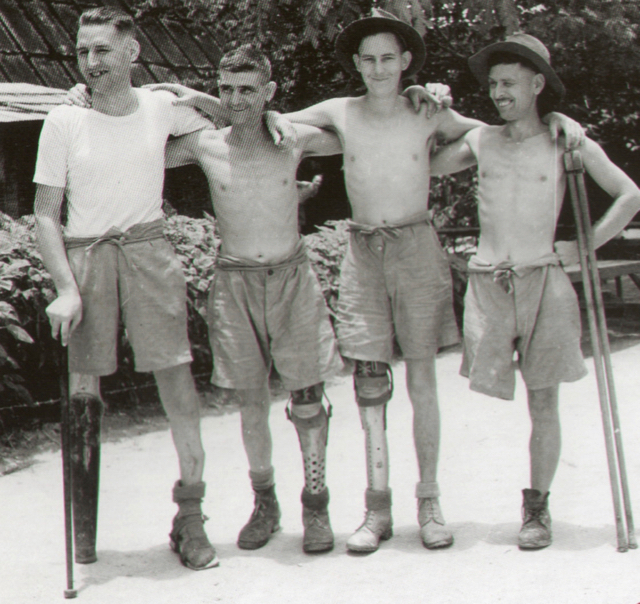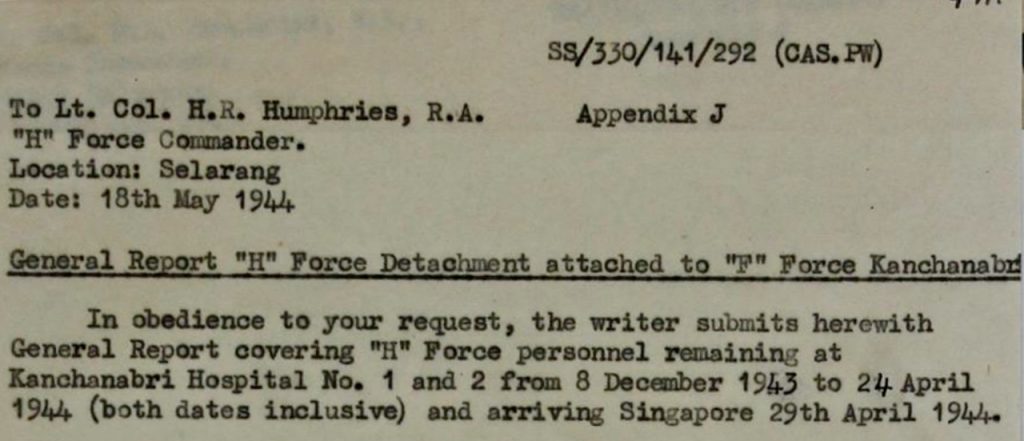The Soldier's Details

- Surname:
- Gleeson
- First Name:
- Stephen John
- Nick Name:
- Steve
- Rank:
- Private
- Regimental #:
- WX16736
- Company:
- Not Known
- Enlisted:
- 8.09.1941
- Discharged:
- 13.12.1945
- DOB:
- 16.04.1919
- Place of Birth:
- Boulder, Western Australia
- Father's Name:
- Stephen Joseph Gleeson
- Mothers's Name:
- Beatrice Elizabeth Gleeson
- Religion:
- Church of England
- Pre-war Occupation:
- Brick Worker
- Singapore:
- Selarang Camp and Barracks Changi and from Kanchanaburi to Changi Gaol Camp
- Force:
- ‘ H ’ Force Thailand, H Force Group No. 3
- Camps Thailand:
- Kanu II Malayan Hamlet, Kanchanaburi
- Return Details 1945:
- Singapore-Melbourne, 1st Netherlands Military Hospital Ship Oranje; Melbourne-Perth by train.
General Description
Gleeson’s right leg was amputated. He remained at Kanchanaburi when ‘H’ Force returned to Singapore due to illness. He returned with other patients to Singapore after December 1943.
Please read further about ‘H’ Force Thailand.
Stephen (Steve) John Gleeson grew up on a farm at Mundijong. He enlisted 3rd September 1941 recording his birth as 29 July 1922. Born in Boulder in 1923 he was in fact only 18 years of age and underage!
Born in Ireland his father Stephen Joseph Gleeson made his way to the Western Australian Goldfields, to Boulder in the 1900s. He served in AIF WW1. Following his return he met widowed Beatrice Elizabeth Leonard and her young daughter. They married in Boulder in 1922. In 1928 the Gleeson family moved to Mundijong.
There were four girls Pat, Margaret, Eunice and Lillian and two brothers, Norman (AIF) and Dan (RAAF). Steve attended Mundijong School for his primary education and then Perth Boys Technical School. Until his enlistment Steve worked at the local brick works and Rose’s Farm.
With the 2/4th Reinforcements, Stephen Gleeson sailed from Fremantle on the ‘Aquitania’ to Singapore in 1942. Amongst the reinforcements were his mates from Mundijong Bill Swann, George Leipold and Syd Darby. Read about the Five from Mundijong.
Steve left Singapore with H Force Group 3 on 8th May 1942. Initially this was an all-Australian force under the command of Lt-Col R.F. Oakes. This group later collected further POWs to make up 500 Australians, 200 British and some Americans.
H Force suffered some of the largest number of death rates on the railway. Harsh conditions, little food and rains resulted in cholera, beriberi, malaria and tropical abscesses as well as ever-frequent bashings by guards.
Steve developed a tropical ulcer on his leg, which required amputation below his knee. His amputation would have taken place with minimal or no anaesthetic and under tenuous conditions including limited medical tools. His strength of character was essential to his recovery as was the dedication of the soldiers who acted as medical orderlies and the doctors.
Above: the official letter confirming POWs who remained in Kanchanaburi Hospital from 8 Dec 1943 to 24 April 1944 – Steve Gleeson’s name was included on the list. We believe the amputation would have taken place at Kanchanaburi.
When H Force returned to Changi December 1943 Steve remained at the hospital at Kanchanaburi. He would have initially been sent to Australian General Hospital at Roberts Barracks then to Changi Gaol Camp.
Whilst at Changi he overcame a bout of malaria, cholera and had his appendix removed. Steve also acquired an artificial leg made for him by other amputees under the guidance of WO Arthur Purdon, 2/30th Battalion. The leg was made from a crashed Japanese plane.
Please read further about Gleeson’s Changi leg
At war’s end, Steve left Singapore for Melbourne on Oranje, 1st Netherlands Medical Ship. Then Troop train from Melbourne to Perth. He was discharged from the Army in December 1945.
Returning to his family at Mundijong he learnt his mother had died whilst he was away. In 1946 Steve’s father died and Steve undertook the role of caretaker of his two younger sisters.
In 1947 Steve married Ethel Coffee from nearby Serpentine. They made a home for themselves and their children at Inglewood whilst Steve trained as a limb maker through the Department of Post War Reconstruction.
Steve’s dreams of farming life or playing sport were lost on the Thai-Burma Railway.
In 1957 Steve and his family moved to Melbourne where he took up the position of Assistant Manager at the Post War Limb Association. In December 1958 he accepted the position of Manager in Adelaide. The family settled and remained in SA.
On retirement Steve volunteered his time to RSL, Limbless Soldiers Assoc. and St Vincent De Paul Society. He also developed a passion for winter lawn bowling. As well he was a keen gardener of vegetables and roses, maintained a small orchard and kept chooks. He was a handyman and enjoyed woodwork. Steve also had an interest in racing pigeons which he raced and bred.
**One wonders whether Mundijong boy and mate George Leipold sold Steve one of his homing pigeons whilst they were at school! (See George Leipold WX16355)
Most of all Steve was proud of his children and grandchildren and took a great interest in their lives. In fact his retirement was so hectic his daughters joked they had to make an appointment to see him!
Steve and Ethel had also purchased a caravan and enjoyed short trips away until Ethel developed cancer in 1981. Ethel passed away in March 1985.
Devastated with his loss Steve decided to make his long awaited trip to the north of WA and to visit relations. He unexpectedly passed away in October 1985 at Overlander near Carnarvon, seven months after Ethel died. His body was returned to SA to be buried with Ethel at Centennial Park.
The Gleeson’s had five children. Sandra, Patricia, Diane, Maree and Stephen.
He was a mate to George Leipold, Bill Swann, Syd Darby and would have known Hector Bishop also from Mundijong.
Syd Darby, Bishop and Leipold died during the battle for Singapore.
(Our thanks to Steve Gleeson’s daughter Sandra who provided much of the above information).

The famous photograph!
Below: Gleeson’s leg which he donated to AWM.



We wish to acknowledge the following information has been copied from the AWM.
History / Summary
This relic relates to the service of WX16376 Private Stephen John Gleeson. Gleeson was born on 16 April 1923 at the town of Boulder, Western Australia and was working as a trucker when he enlisted in the Second AIF on 8 September 1941, overstating his age by four years. After a period of training he was allocated to the 2/4th Machine Gun Battalion. He embarked for overseas service from Fremantle on 15 January 1942, arriving at Singapore on 26 January. He was at Singapore for less than a month before he was taken prisoner by the Japanese on 15 February and was interned at Changi.
Gleeson was in hospital with appendicitis for four days from 3 October. On 13 December he was readmitted with appendicitis. This time his appendix was removed and he was discharged on 10 January. Four months later on 8 May 1943 he embarked with H Force to work on the Thai-Burma Railway.
In all, 9,500 Australian prisoners of war worked on the construction of the Burma-Thailand Railway, which ran from Bampong, Thailand, to Thanbyuzayat, Burma. The railway was completed on 16 October 1943.
After completion of the railway the surviving prisoners were sent to recovery camp. By the end of December 1943, most prisoners from H force had returned to Changi, with only the sickest remaining behind.
At some point after he left for Thailand, possibly in 1943 while working on the railway, Gleeson’s right leg was amputated below the knee. While working on the railway in the jungle, many prisoners got cuts or abrasions on their legs due to the lack of proper clothing and footwear. These sores often became septic due to the conditions the prisoners were living in, and in a large number of occasions caused for the limbs to be amputated. This is what may have happened to Gleeson.
Gleeson remained in Changi from 1944 and was liberated from Changi on 5 September 1945.
This leg was made for Gleeson while in Changi by NX67447 Warrant Officer Arthur Henry Mason Purdon, 2/30th Battalion. Purdon was born on 24 December 1900 and was working as a health inspector when he enlisted in the Second AIF on 17 January 1941. He had earlier served in the First World War in the 3rd Battalion, AIF with the service number 7797 and in the permanent Military Forces. In 1926 he married Doris Fitzgerald.
He embarked for Singapore with the 2/30th Battalion on 29 July, arriving 15 August. He fought with his battalion at Gemas, Malaya and when the battalion withdrew from the area on 16 January 1942, he was the last to leave as he assisted the wounded from the battlefield while under small arms and mortar fire. During the fighting he also took rations forward despite the bombing and shelling, always getting the food to the most forward troops. Purdon was later awarded the Distinguished Conduct Medal for his actions during this time.
He was also taken prisoner at Singapore on 15 February 1942 and was initially held at Changi. During his captivity he established a limb factory to make artificial limbs made from aluminium and other waste metal taken from Japanese dumps for his fellow prisoners who had their legs amputated. As part of this work he invented the Purdon joint, which allowed the limbs to move in a similar fashion to a normal leg. By the end of April 1944 he had made limbs for 43 men and was going to have to make more.
On 27 June 1945, Purdon was moved to the Adam Park Camp at Singapore in charge of 49 other members of 2/30th Battalion. He was liberated from this camp on 8 September 1945. Purdon died on 2 August 1983.”
Camp Locations:
- Changi Gaol Camp - Singapore
- Selarang Barracks Changi - Singapore
- Selarang Camp Changi - Singapore
- Kanchanaburi, 50k - Thailand
- Kanu II, 152.30k - Thailand






